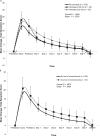Predicting Recovery Patterns After Sport-Related Concussion
- PMID: 28387552
- PMCID: PMC5384825
- DOI: 10.4085/1062-6050-52.1.12
Predicting Recovery Patterns After Sport-Related Concussion
Abstract
Context: Clinicians sometimes treat concussed individuals who have amnesia, loss of consciousness (LOC), a concussion history, or certain symptom types more conservatively, but it is unclear whether recovery patterns differ in individuals with these characteristics.
Objective: To determine whether (1) amnesia, LOC, and concussion history influence the acute recovery of symptoms, cognition, and balance; and (2) cognition and balance are influenced by acute symptom type.
Design: Cohort study.
Setting: Seven sports at 26 colleges and 210 high schools.
Patients or other participants: A total of 8905 collegiate (n = 1392) and high school (n = 7513) athletes.
Main outcome measure(s): The Graded Symptom Checklist, Standardized Assessment of Concussion, and Balance Error Scoring System were administered to all athletes during the preseason. To allow us to track recovery patterns, athletes diagnosed with a concussion (n = 375) repeated these assessments immediately after the injury, 3 hours postinjury, 1 day postinjury, and at 2, 3, 5, 7, and 90 days after injury.
Results: Athletes who experienced amnesia had markedly greater deficits in and a slower recovery trajectory on measures of symptoms, cognition, and balance. Athletes with 2 or more prior concussions demonstrated poorer balance than those with no previous history. Otherwise, LOC and concussion history largely did not affect symptoms, cognition, or balance. Greater deficits in balance scores were observed in athletes with all symptom types. Regardless of these characteristics, most athletes recovered within 7 to 10 days.
Conclusions: Athletes who experienced amnesia had more symptoms and greater deficits in cognition and balance. Symptoms and cognitive or balance deficits were not consistently associated with LOC or concussion history. Acute symptoms had a strong influence on balance scores and, to a lesser extent, on cognition. However, we found no evidence to support more cautious return-to-play decisions for athletes with these characteristics, as group recovery occurred within normal timelines. Our study supports current clinical practice: recommending that athletes be withheld from activity until they are asymptomatic, followed by a graduated return-to-play progression.
Keywords: Balance Error Scoring System; Standardized Assessment of Concussion; return to play; traumatic brain injuries.
Figures






References
-
- Lincoln AE, Caswell SV, Almquist JL, Dunn RE, Norris JB, Hinton RY. . Trends in concussion incidence in high school sports: a prospective 11-year study. Am J Sports Med. 2011; 39 5: 958– 963. - PubMed
-
- Marar M, McIlvain NM, Fields SK, Comstock RD. . Epidemiology of concussions among United States high school athletes in 20 sports. Am J Sports Med. 2012; 40 4: 747– 755. - PubMed
-
- Guskiewicz KM, McCrea M, Marshall SW, et al. . Cumulative effects associated with recurrent concussion in collegiate football players: the NCAA Concussion Study. JAMA. 2003; 290 19: 2549– 2555. - PubMed
-
- McCrea M, Guskiewicz KM, Marshall SW, et al. . Acute effects and recovery time following concussion in collegiate football players: the NCAA Concussion Study. JAMA. 2003; 290 19: 2556– 2563. - PubMed
-
- Kirschen MP, Tsou A, Nelson SB, Russell JA, Larriviere D; Ethics, Law, . and Humanities Committee, a Joint Committee of the American Academy of Neurology, American Neurological Association, and Child Neurology Society. Legal and ethical implications in the evaluation and management of sports-related concussion. Neurology. 2014; 83 4: 352– 358. - PubMed
Publication types
MeSH terms
LinkOut - more resources
Full Text Sources
Other Literature Sources
Medical

